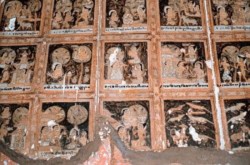Difference between revisions of "Jātaka"
(Created page with "thumb|250px| Jātaka means ‘about birth’ and is the name of a book in the Khuddaka Nikāya, the fifth part of the Sutta Piṭaka which is the first ...") |
|||
| Line 1: | Line 1: | ||
[[File:Jataka.jpg|thumb|250px|]] | [[File:Jataka.jpg|thumb|250px|]] | ||
| − | Jātaka means ‘about birth’ and is the name of a book in the Khuddaka Nikāya, the fifth part of the Sutta Piṭaka which is the first division of the Tipiṭaka, the sacred scriptures of Buddhism. The Jātaka consists of 547 stories – some quite brief, others very long – illustrating Buddhist virtues like | + | Jātaka means ‘about birth’ and is the name of a book in the [[Khuddaka Nikāya]], the fifth part of the [[Sutta]] Piṭaka which is the first division of the Tipiṭaka, the sacred scriptures of [[Buddhism]]. The Jātaka consists of 547 stories – some quite brief, others very long – illustrating Buddhist virtues like [[Kindness]], prudence, honesty, self-sacrifice, courage and determination. The characters in many of the stories are [[Animals]]. The early Buddhists culled many of these stories from the great store of Indian folklore and fables and made them Buddhist by saying that the hero of each story was actually [[The Buddha]] in one of his former lives as a [[Bodhisattva]]. Other stories are purely Buddhist creations. |
| − | The Jātaka consists of four parts. Preceding all the stories is a long introduction (''nidānakathā''), which relates tells the traditional | + | The Jātaka consists of four parts. Preceding all the stories is a long introduction (''nidānakathā''), which relates tells the traditional [[LIFE OF THE BUDDHA]] from his aspiration to become a [[Buddha]] up to the founding of the first [[Monastery]]. Each story is prefaced by a ‘story of the present’ (''paccuppanna vaṇṇa''), giving the reasons why [[The Buddha]] told the story, and ends with a ‘connection’ (''samodhāna'') in which the characters in the story are identified. The stories themselves (atīta vatthu) are in prose and imbedded within them are verses (''gāthā''), of which there are about 2500 altogether. Only these verses are considered the actual words of [[The Buddha]]. With their lively plots, well-defined characters and flashes of humor, the Jātaka has long been one of the most popular [[Books]] in the scriptures. Scholars believe that some of the fables of Aesop and many other collections of folklore have their origins in the Jātaka. |
The Jātaka, trans. by R. Chalmers, H.T. Francis, E.B. Cowell and W.H.D. Rouse, 1990. | The Jātaka, trans. by R. Chalmers, H.T. Francis, E.B. Cowell and W.H.D. Rouse, 1990. | ||
| Line 10: | Line 10: | ||
[[Category:Buddha Shakyamuni]] | [[Category:Buddha Shakyamuni]] | ||
[[Category:Buddhist Terms]] | [[Category:Buddhist Terms]] | ||
| + | [[Category:Jātakas]] | ||
Revision as of 02:20, 9 May 2013
Jātaka means ‘about birth’ and is the name of a book in the Khuddaka Nikāya, the fifth part of the Sutta Piṭaka which is the first division of the Tipiṭaka, the sacred scriptures of Buddhism. The Jātaka consists of 547 stories – some quite brief, others very long – illustrating Buddhist virtues like Kindness, prudence, honesty, self-sacrifice, courage and determination. The characters in many of the stories are Animals. The early Buddhists culled many of these stories from the great store of Indian folklore and fables and made them Buddhist by saying that the hero of each story was actually The Buddha in one of his former lives as a Bodhisattva. Other stories are purely Buddhist creations. The Jātaka consists of four parts. Preceding all the stories is a long introduction (nidānakathā), which relates tells the traditional LIFE OF THE BUDDHA from his aspiration to become a Buddha up to the founding of the first Monastery. Each story is prefaced by a ‘story of the present’ (paccuppanna vaṇṇa), giving the reasons why The Buddha told the story, and ends with a ‘connection’ (samodhāna) in which the characters in the story are identified. The stories themselves (atīta vatthu) are in prose and imbedded within them are verses (gāthā), of which there are about 2500 altogether. Only these verses are considered the actual words of The Buddha. With their lively plots, well-defined characters and flashes of humor, the Jātaka has long been one of the most popular Books in the scriptures. Scholars believe that some of the fables of Aesop and many other collections of folklore have their origins in the Jātaka.
The Jātaka, trans. by R. Chalmers, H.T. Francis, E.B. Cowell and W.H.D. Rouse, 1990.
